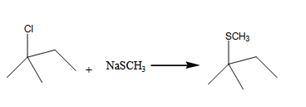
a)
Interpretation:
The expected product between the
Answer to Problem 21VC
The ethyl chloride undergoes SN2 reaction with Na+SCH3- and NaOH to yield a product.
The product is CH3CH2SCH3, CH3CH2OH.
Here the leaving group is Cl.
The nucleophile is SCH3-,OH.
Hence it undergoes SN2 reaction.
Explanation of Solution
The ethyl chloride undergoes SN2 reaction with Na+SCH3- and NaOH to yield a product.
The product is CH3CH2SCH3, CH3CH2OH.
Here the leaving group is Cl.
The nucleophile is SCH3-,OH.
Hence it undergoes SN2 reaction.
The ethyl chloride undergoes SN2 reaction with Na+SCH3- and NaOH to yield a product.
The product is CH3CH2SCH3, CH3CH2OH.
Here the leaving group is Cl.
The nucleophile is SCH3-,OH.
Hence it undergoes SN2 reaction.
b)
Interpretation:
The expected product between the alkyl halide CH3CH2Cl+Na+SCH3- and NaOH is interpreted.
Answer to Problem 21VC
The alkyl halide undergoes SN1 reaction with Na+SCH3- to yield a SCH3 Substituited product.
The product is shown in the reaction.
In this reaction leaving group is Cl, the nucleophile is SCH3-

Explanation of Solution
The alkyl halide undergoes E1 reaction with NaOH to yield a
The product is shown here

The alkyl halide undergoes SN1reaction with Na+SCH3- to yield a SCH3 Substituited product.
The product is shown in the reaction.
In this reaction leaving group is Cl, the nucleophile is SCH3-

c)
Interpretation:
The expected product between the alkyl halide CH3CH2Cl+Na+SCH3- and NaOH is interpreted.
Answer to Problem 21VC
The benzylchloride undergoes SN1 reaction with Na+SCH3- to yield a product.
The product is shown here.

Here the leaving group is Cl.
The nucleophile is SCH3-Hence it undergoes SN1 reaction.
Explanation of Solution
The benzylchloride undergoes E1 reaction with NaOH to yield a product.
The product is shown here

The benzylchloride undergoes SN1 reaction with Na+SCH3- to yield a product.
The product is shown here.

Here the leaving group is Cl.
The nucleophile is SCH3- Hence it undergoes SN1 reaction.
Want to see more full solutions like this?
Chapter 11 Solutions
EBK ORGANIC CHEMISTRY
- A mixture of C7H12O2, C9H9OCl, biphenyl and acetone was put together in a gas chromatography tube. Please decide from the GC resutls which correspond to the peak for C7,C9 and biphenyl and explain the reasoning based on GC results. Eliminate unnecessary peaks from Gas Chromatography results.arrow_forwardIs the molecule chiral, meso, or achiral? CI .CH3 H₂C CIarrow_forwardPLEASE HELP ! URGENT!arrow_forward
- Identify priority of the substituents: CH3arrow_forwardHow many chiral carbons are in the molecule? OH F CI Brarrow_forwardA mixture of three compounds Phen-A, Acet-B and Rin-C was analyzed using TLC with 1:9 ethanol: hexane as the mobile phase. The TLC plate showed three spots of R, 0.1 and 0.2 and 0.3. Which of the three compounds (Phen-A; Acet-B or Rin-C) would have the highest (Blank 1), middle (Blank 2) and lowest (Blank 3) spot respectively? 0 CH: 0 CH, 0 H.C OH H.CN OH Acet-B Rin-C phen-A A A <arrow_forward

 Organic ChemistryChemistryISBN:9781305580350Author:William H. Brown, Brent L. Iverson, Eric Anslyn, Christopher S. FootePublisher:Cengage Learning
Organic ChemistryChemistryISBN:9781305580350Author:William H. Brown, Brent L. Iverson, Eric Anslyn, Christopher S. FootePublisher:Cengage Learning

